Gurdwara Sis Ganj Sahib is one of the nine historical Gurdwaras in Delhi. It was first constructed in 1783 by Baghel Singh to commemorate the martyrdom site of the ninth Sikh Guru, Guru Tegh Bahadur. situated in Chandni Chowk in Old Delhi, it marks the site where the ninth Sikh Guru was beheaded on the orders of the Mughal emperor Aurangzeb on 11 November 1675 for refusing to convert to Islam.
History
The ninth Sikh Guru, Guru Tegh Bahadur was beheaded here on 11 November 1675 on the orders of Mughal Emperor Aurangzeb when Guru Tegh Bahadur protested against the forceful conversion of Kashmiri Pandits and non-Muslims to Islam. However, before his body could be quartered and exposed to public view, it was stolen under the cover of darkness by one of his disciples, Lakhi Shah Vanjara who, then burnt his house to cremate Guru's body; today, at this site stands Gurdwara Rakab Ganj Sahib.
The trunk of the tree beneath which the head of the Guru was severed and the well used by him for taking bath during his prison term have been preserved in the shrine. Also, adjoining the gurudwara, stands the Kotwali (police station), where Guru was imprisoned and his disciples were tortured. Located close to it is the Sunehri Masjid (Chandni Chowk).

Sheesh Ganj Gurudwara
On 11 March 1783, Sikh military leader Baghel Singh (1730–1802) marched into Delhi along with his army. He occupied the Diwan-i-Am, the Mughal emperor Shah Alam II made a settlement with them agreeing to allow Baghel Singh to raise gurudwaras on Sikh historical sites in the city and receive six annas in a rupee (37.5%) of all the octroi duties in the capital. Sis Ganj was one of the shrines built by him, within the time span of eight months, from April to November 1783. However, due to volatile political climate in the coming century, the site alternated between being a mosque and a gurudwara. It became a site of dispute between two communities, and litigation followed. Eventually after prolonged ligation the Privy Council during British Raj ruled in the favour of the Sikh litigants and the present structure was added in 1930; gold gild of the domes was added in the coming years. The Kotwali was handed over to the Delhi Sikh Gurdwara Management Committee around
The severed head ("Sis" in Hindi or Punjabi) of Guru Tegh Bahadur was brought to Anandpur Sahib by Bhai Jaita, another disciple of the Guru. Another gurudwara by the same name, Gurudwara Sisganj Sahib at Anandpur Sahib in Punjab, marks this site, where, in November 1675, the head of the martyred Guru Teg Bahadur, brought by Bhai Jaita (renamed Bhai Jivan Singh according to Sikh rites), in defiance of the Mughal authorities, was cremated.
Gurdwara Rakab Ganj Sahib
In order to awaken the conciousness of the masses and to focus the minds of the nation's elite, the ninth Sikh Guru volunteered to lay down his life so that the atrocities of the cruel Mughal empire could be thrown into the forefront of issues that were deemed important for the country at the time. Consequently, the execution of the Guru in 1675 spelt the beginning of the end of the Mughal empire.
Background
Two brave Sikhs of the Guru, Bhai Lakhi Shah Banjara and his son, Bhai Naghaiya rescued the headless body of the revered ninth Sikh Guru from Chandni Chowk, Delhi after the execution of the Guru.Guru ji's body was rescued by these two with a convoy of several ox-driven carts carrying bales of cotton and foodstuffs. Due to the strong dust storm, these brave Sikhs managed to lift the body of the Guru without the Mughal guards discovering what was going on.
These two Sikhs were able to lift the body with great speed under the cover of the storm and then conceal the body in the cart under bales of cotton. They then quickly moved towards Raisina village, the place where they lived. On reaching their abode they were able to avoid any suspicion by the authorities since Bhai Lakhi Shah Banjara placed the body on a bed and set fire to his whole house.
This place came to be known as Rakab Ganj. This tragic death of the Guru and his dedicated companions took place on November 11, 1675 under orders of the Mughal Emperor Aurangzeb. Another devoted Sikh, Bhai Jaita took the Guru ji's head to Anandpur Sahib, 500Km (300 miles) away from Sis Ganj, Chandni Chowk.
See Martyrdom of Guru Tegh Bahadur Sahib for further details.
Modern Building
Panoramic view - front
Historic Account
Historical records show that Sardar Baghel Singh, constructed a Gurdwara in village Raisina in 1783 to perpetuate the memory of the ninth Guru Sri Tegh Bahadur. He had conquered Delhi by leading an army of 30,000 Sikh warriors along with four other commanders. Before 1783, the Muslims of Delhi had built a mosque on this very spot. The Sikhs claimed this spot as their own sacred place in memory of the sacrifice to their Guru. Muslims contested the claim, and there was strong objection to the dismantling of the Mosque.Rival parties stood with swords drawn and the atmosphere was tense - anything could have happened. However, the Sikhs offered to reconstruct the mosque for the Muslims with their own expense in case the urn containing the ashes of the respected Guru was not found buried beneath the Mosque that stood there. This helped calm the atmosphere and tempers cooled down. The excavation work commenced in the presence of the Mughal officials.
The assertion made by the Sikhs proved to be correct and they were allowed to construct Gurdwara Rakab Ganj by Emperor Shah Alam II. He also granted two Sanads to Sikhs. One Sanad granted permission to S. Bhagel Singh to take possession of the land for construction of a Gurdwara and a garden. By the second Sanad, the Emperor also gifted 101 bighas and 5 biswas pukhta equal to about 63 acres with 3 wells land, revenue free. Sikh forces agreed to withdraw from Delhi territory peacefully after the construction of their religious shrines in the Mughal capital in lieu of these concessions.
Gurdwara Sis Ganj Sahib
(Redirected from Sis Ganj)
Before his body could be quartered, further disrespected and exposed to public view, it was recovered under the cover of darkness caused by a severe dust storm by one of the Guru's disciples, Lakhi Shah Vanjara, who then set his home alight to cremate the Guru's body.
Similarly, the 'Sis' (head) of Guru Tegh Bahadur was recovered and taken to Anandpur Sahib by Bhai Jaita, another Sikh of the Guru where it was cremated by the Guru's young son, Guru Gobind Rai.
Bhai Jaita who had been of the Majhabi (scavenger) caste, was renamed Bhai Jivan Singh on the day that Guru Gobind Rai created the Khalsa in 1699 and added the names Singh or Kaur to the names of all initiated Sikhs. Bhai Jivan Singh was one of the Martyrs at Chamkaur. Guru Gobind Singh was the tenth and last living Guru of the Sikhs.
Across the road and facing the Gurdwara Sis Ganj is the site of the Kotwali (police station), where the faithful disciples of the Great Guru Bhai Mati Das, Bhai Dyala and Bhai Sati Das were tortured to death at about the same time.
Panoramic view inside Gurdwara Sis Ganj Sahib
There are nine historic Gurdwaras, associated with important events which occurred here in this city. Events which had a great bearing on the history of Punjab and of India changing its course and direction. Consequently it has become a renowned place of pilgrimage, sacred to the Sikhs as at least five Sikh Gurus; Nanak Dev, Hargobind, Harkrishan, Tegh Bahadur and Gobind Singh spent time in Delhi.
It was in this city that the young Guru Harkrishan, who ascended to his heavenly abode here of smallpox contracted in the ancient city, passed the Guruship to someone he called "Baba Bakala". "Baba Bakala" turned out to be his elder brother Tegh Bahadur or Tegh Mal who later, as previously mentioned, became the second Guru of the Sikhs to die here in Delhi. The last Sikh Guru, Guru Gobind Singh continued the mission to bring peace and freedom to this nation. However, the mission would not be achieved until many thousands of more captured Sikhs met their deaths in Delhi, including Banda Singh Bahadur who dedicated his everything for his Guru and master, Guru Gobind Singh.
City glows with the light of fallen jewels
This ancient city is soaked with the sacred blood of many thousands of Sikh jewels; the brave and fearless martyrs who died purely and simply to maintain, defend and fight for the most noble of human causes - the protection of ones liberty, the right to practise ones own religion and the freedom to live with the assurance of justice.The Sikh Gurus, beginning with Guru Arjan Dev and continuing with Guru Tegh Bahadur lit the path for the Sikhs to follow; and as history confirms, the Sikhs did not flinch from their duty. Many hundreds and thousands of Sikhs did not hesitate in stepping on this difficult and treacherous path as is evident from the many monuments and landmarks still present in this great city to commemorate the fallen Sikh heroes both of the 18th century and beyond.
In Guru Tegh Bahadur, Banda Singh Bahadur, Jassa Singh Ahluwalia, Bhai Baghel Singh, Bhagat Singhand many others we find the gritty determination to root out the tyranny of injustice from this sacred land of the saints; their blood and sweat soaked into the soil of this historic city. Was it not for these determined souls of the Lord, the city would not have the independence, democracy and freedom that is enjoyed by the city dwellers today - One hopes that this fact will always be remembered by the residence as they go about their daily carefree lives now and in the future.
Banda Singh Bahadur
The village Budhkhalsa where Banda Singh Bahadur camped, is situated along the Grand Trunk Road (Shershah Suri Marg). This great Sikh hero shook the Mughal Empire to its core in Punjab giving crushing blows to the Imperial Army and capturing the tract of land, lying between the Yamuna and Sutlej rivers.After his defeat in 1716, Banda Bahadur was brought to Delhi as a prisoner along with 1,000 followers, who were beheaded in Gandhi ground opposite Old Delhi Railway Station at a site known as, Qaza1-Gahe Sikhan near Qutab Minar situated in Mehrauli, a suburb of Delhi. Two stone pillars of a gateway overlooking the Dargah of Khwaja Bakhtiar Kakistill still stand as a witness to the martyrdom of Baba Banda Bahadur. Harding Library (now renamed Hardyal Library) stands on this site today.
Nearby a 50 ft. high pillar made of stone with a steep stains, now houses a Gurdwara in memory of the supreme sacrifice made by the Jathedar appointed by Guru Gobind Singh. After his Martyrdom over 100 Sikhs were killed daily for about 100 days.
Every day thousands of pilgrims throng these holy shrines to listen to kirtan (devotional music) from the Guru Granth Sahib.
The wife of Guru Gobind Singh, Mata Sundri and Mata Sahib Kaur (the Mother of the Khalsa), who provided the 'Amrit' that day when the Khalsa was born, lived in Delhi for 35 years after the Guru's death. They issued directions to the Sikh forces from the Gurdwara Mata Sundri, Delhi. This Gurdwara near the Turkman Gate was built to perpetuate their memory.
Sardar Bhagel Singh, the commander of the Kironsinghia Misal, who held Delhi under his sway for some months in 1783, during the time of Shah Alam ll, took special pains to locate the sites of these historical events. He made a great contribution to the Sikh religion by constructing Gurdwaras, over all these historic sites in Delhi.
In March 1783, a large Sikh Army commanded by Jassa Singh Ahluwalia, Bhagel Singh Kironsinghia, Rai Singh Bhangi and Gurdit Singh, Raja of Ladwa, advanced to the imperial capital and attacked the Red Fort. Tis Hazari was so named by Bhagel Singh, because he had used the site as a stable for 30,000 horses of his cavalry.
The Mughal King opened negotiations. The Sikhs received Rs. three lakhs in cash as Nazrana and the permission to build their shrines on the historic sites, where mosques had been built. Bhagel Singh remained in Delhi as the head of 4,000 Sikh troops who built the Gurdwaras.
It is important to mention that when the Sikhs came into power in Punjab, after pushing out the Afghans, they fought pitched battles with the Mughal forces on the sandy beds of Yamuna river, where now stands Indraprastha Indoor Stadium. A small Gurdwara indicates the spot near the Indraprastha power station, where two forces clashed for supremacy.
POSTED BY : VIPUL KOUL
EDITED BY ; ASHOK KOUL


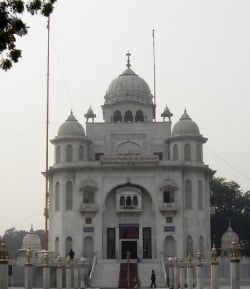
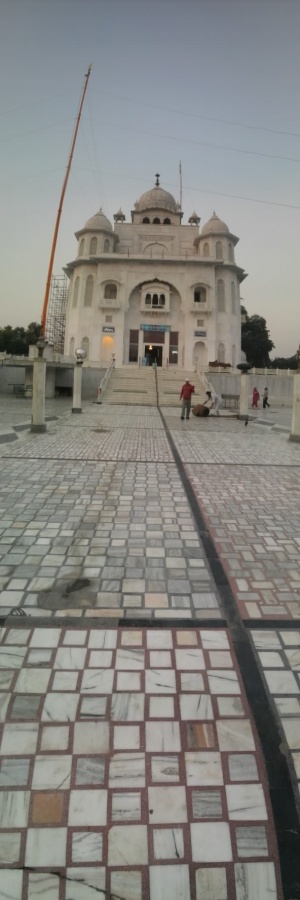
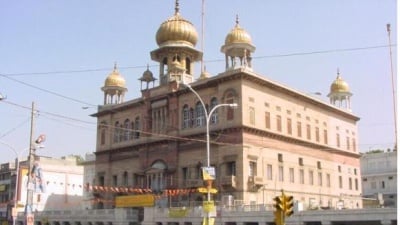
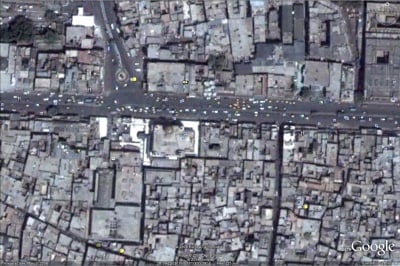
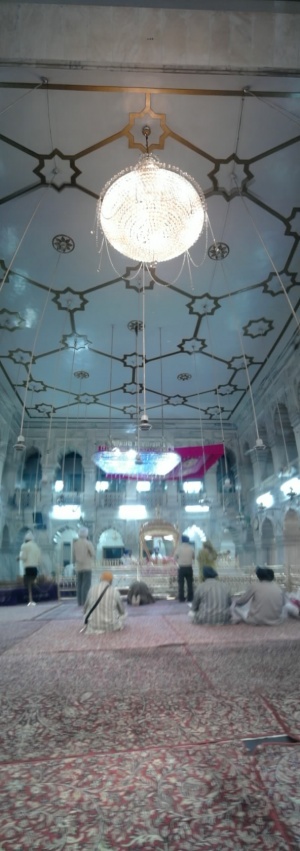

No comments:
Post a Comment